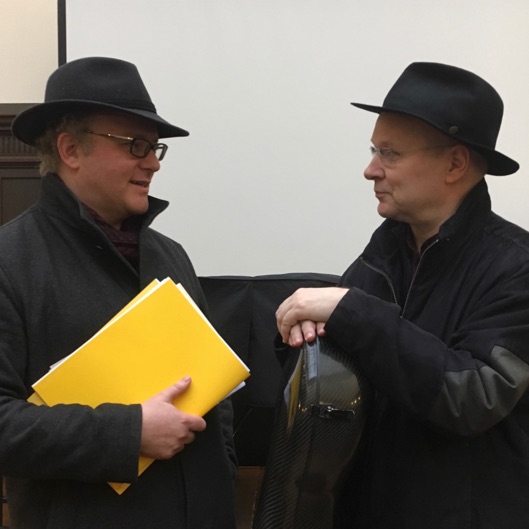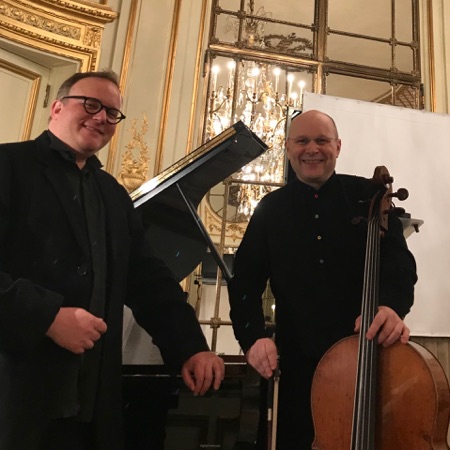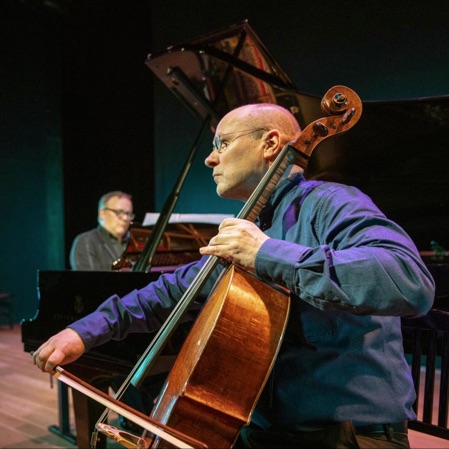San Francisco Cronicle
Review: Betsy Jolas’ underrated and ethereal music shines forth in Berkeley
Joshua Kosman March 11, 2019
As the classical music world finally begins to tackle — with varying degrees of energy and commitment — the business of according women their rightful place in the cultural landscape, one obvious direction to turn is toward the work of the perpetually undervalued French composer Betsy Jolas.
She’s a musician more known about than known, a name that crops up repeatedly in histories but rarely in the concert hall. And at 92, she’s still composing music of ethereal grace and imagination.
Two of Jolas’ recent works formed the centerpiece of an engaging program of contemporary chamber music presented by Cal Performances on Sunday, March 10, in UC Berkeley’s Hertz Hall. The players — pianist Nicolas Hodges, violinist Jennifer Koh and cellist Anssi Karttunen — formed a crack squad of new-music interpreters, and the other works on the program were by the triumvirate that a friend refers to as the Finnish All-Stars: future San Francisco Symphony music director Esa-Pekka Salonen (due for a Berkeley visit this weekend with London’s Philharmonia Orchestra) and his estimable friends and compatriots, Kaija Saariaho and Magnus Lindberg.
Yet it was Jolas whose music proved most delightful and novel — if only because one encounters it so rarely — and left a listener wondering what other treasures might be ripe for discovery.
The main offering was “Femme le soir (Woman in the evening),” a collection of eight short pieces for cello and piano that Jolas subtitled “lieder,” or songs. There’s an old tradition of asking instruments to do the work of singers — Mendelssohn’s “Songs Without Words” for piano represent perhaps the most famous example — and Jolas’ piece both inhabits that lineage and blows it up from within.
There are melodies here, of course, some of them lyrical and tender, but they’re often glimpsed in fragmentary form, as if through the scrim of memory. Interactions between the two performers can be spare, even deferential, with one picking up an idea from the other who then sits back to hear it developed.
Jolas occasionally uses extended instrumental techniques that take the music out of its frame a bit — percussive knocking on the body of the cello or piano, a foray into the interior of the piano to strum the strings directly, and in one case a snatch of spoken dialogue as if to suggest the limits of purely instrumental communication. These are all gestures that can easily feel gimmicky, but Jolas wields them with perfectly judged aptness.
The music draws on an unorthodox collection of influences, including Renaissance polyphony, French impressionism and some of the more humane strands of late European modernism, yet it sounds like nothing but itself – firm but pliable, rhythmically adept, and full of expressive ardor (especially in the exquisitely beautiful final song). Hodges and Karttunen, who premiered the work in December, gave it a magnificent and loving performance.
Also from last year came “Toi x 3,” a shapely trio of piano pieces that Hodges delivered in all its eloquent splendor. There are fragrant, slightly overripe chords to start with, a formidably etched melody that emerges from them with fierce determination, and once again the judicious use of instrumental effects to make a much-needed point.
In Berkeley, a knockout U.S. premiere for cello and piano
By Joshua Kosman Monday, October 30, 2017
“So who is Pascal Dusapin?” asked a friend during the intermission of Sunday’s duo recital by cellist Anssi Karttunen and pianist Nicolas Hodges, as we tried to assimilate the depth and extent of the musical masterpiece we’d just taken in.
I did my best to answer her query — French composer, in his mid-60s, modernist of a certain not entirely mainstream bent — but I was struggling, and the consequent urge to self-reproach was strong. Suddenly, all the hours I’d devoted to anything except acquiring a thorough acquaintance with Dusapin’s oeuvre struck me as grievously ill-spent
The inspiration for all of this was a four-movement piece titled “Slackline,” which received its U.S. premiere in Berkeley’s Hertz Hall as part of a program presented by Cal Performances (the work’s commissioner). To listen to this music, in Karttunen and Hodges’ eloquent, sure-handed rendition, was to feel a constant combination of surprise and confidence — every moment of the piece seemed new and unexpected, and yet it all made glorious sense.
Also, the music is surpassingly beautiful, which has not always been the case in my encounters with Dusapin’s work. But “Slackline” boasts a vivid, almost ingratiating air of immediacy, an urgent desire to engage the listener without compromise or sentimentality.
Each of the duo’s movements is briskly, unmistakably characterized in both mood and technique. The opening movement, marked “Peaceful,” grows out of a simple, easily grasped melody that serves as the substance for a long and ingenious musical essay. The discussion is by turns urgent and reflective, but always keeps the main theme — and, most tellingly, its harmonic underpinnings — somewhere in sight.
Dusapin follows this with an exuberant crowd-pleaser, a ferociously fast, unbroken stream of barrelhouse piano into which the cello makes dogged interjections without much hope of stanching the flood. The music proved so sleek and wonderful that not even a short hiatus while a patron found and silenced a ringing cell phone could diminish its luster.
But wait, there’s more! The whirlwind is followed by an eerie boneyard of long-held string harmonics and spare, translucent harmonies, and then a celebratory finale launched by a series of chiming piano chords reminiscent of Messiaen. By the time “Slackline” had run its nearly 25-minute course, audience members felt we had been through a landmark experience — and wanted nothing more than to hear the piece again.
Even if nothing else on the program matched that exhilarating high, the partnership of Karttunen and Hodges turned out to be equally alluring in both new and old music. They led off with the U.S. premiere of “Fling,” a short curtain-raiser by the Iranian-born composer Ashkan Behzadi that turned out to be an entirely sculptural collection of musical gestures — tone clusters, string effects, tiny bursts of sound — arranged in compellingly abstract combinations.
The program also had promised a commissioned world premiere by Sean Shepherd, but that was replaced at the last minute by Fred Lerdahl’s Duo for Cello and Piano. In its U.S. premiere, this emerged as a 15-minute dialogue of restrained good manners, in which musical ideas were traded back and forth with genteel consideration but not much force.
The older composers were, unsurprisingly, Beethoven and Brahms, each represented by his final Sonata for Cello and Piano. Karttunen and Hodges gave both works performances of impeccable, if slightly austere, mastery, most appealingly in the slow movement of Beethoven’s D-Major Sonata, Op. 102, No. 2.
Joshua Kosman is The San Francisco Chronicle’s music critic.
San Francisco Classical Voice
New Music That Fits Like an Old Glove
by MICHAEL ZWIEBACH , March 12, 2019
Since most of our classical music heroes lived before the age of recording, we’ve learned to worship the score in order to get closer to them. But as every musician knows, music is a living thing passed on by teaching, by exchange, by unexpected meetings of musicians who inspire and nourish each other’s playing.
This explains the special nature of the concert given by cellist Anssi Karttunen, violinist Jennifer Koh, and pianist Nicholas Hodges at UC Berkeley’s Hertz Hall on Sunday. Produced by Cal Performances, it was a meeting of friends, playing music by composers whose music they all know inside out. In Karttunen’s case, the composers, mostly fellow Finns, are friends, some of whom he’s known since his teenage years.
Koh has been performing Esa-Pekka Salonen’s Lachen Verlernt (Laughter Unlearned) for several years now. The piece is inspired by a phrase from Arnold Schoenberg’s song cycle Pierrot Lunaire. The composer tells us it’s a chaconne (a Baroque dance with a repeating bass line), like Bach’s famous exemplar from the Partita No. 2. It starts off meeting that expectation, but beyond the first few phrases it becomes progressively unhinged, leading to passages of furious bariolage and, eventually, single-string scrubbing. It’s a little strange watching the self-possessed Koh enter into this manic sound world, but she fully expressed the music’s interior monologue.
The real discovery on the program, I suspect for most listeners, was the 92-year-old French-American Betsy Jolas. While she is a highly decorated composer, her music is less often performed in the Anglo-American countries. (Sir Simon Rattle only got to know her music a couple of years ago.) She has a strong literary background, through her parents, and came of age in the postwar era, discovering the serialism of Pierre Boulez and Anton von Webern (to the alarm of Darius Milhaud, one of her teachers at the Conservatoire National.) But she incorporates a range of classical music in her writing.
Femme le soir (Woman in the evening) is one of several cycles of songs without words she has written, and it was premiered last year by Karttunen and Hodges, to whom the piece is dedicated. The first song, “Lulling” begins with an arpeggiated pitch collection in the piano accompaniment that, surprisingly perhaps, ends on a seventh chord. And that’s not the only triad-based harmony in the piece, though it’s not the basis of the music. The cello, in its most beautiful, singing register, traces a soft melody, a fragment of a lullaby.
Jolas constantly displaces the beat in this song (and in all eight songs of the collection), giving the two instrumentalists some independence, but also creating a floating feeling that keeps refreshing your ear. These unassuming pieces — there are only a couple of fortissimo interjections until the fourth song — are practically perfect, a master class in saying something meaningful in a two-minute form. Craft unites with expression, with a frame of reference that far exceeds my own.
Anssi Karttunen’s Modernist Cavalcade
BY DAVID BRATMAN , October 31, 2017
Cellist Anssi Karttunen and pianist Nicolas Hodges, frequent recital partners, came to Berkeley’s Hertz Hall on Sunday, October 29, for a concert featuring the kind of music they like best: extremely new compositions written for themselves to play. There were three of these, all first U.S. performances, and all proving that the spirit of 20th-century modernist composition is alive and active.
The centerpiece of the program, in placement and length as well as heft, was Slackline by the French composer Pascal Dusapin. It’s in four movements and lasted about 25 minutes. It’s more contemplative than the compulsively driving music for which Dusapin became known, and more severely modernist, but it did not lack activity nor interest. A movement titled “Peaceful” featured slow-moving and continuous, mostly chordal, declamatory lines for cello over chromatic tinkling in the piano. Another, “Calm (and relieved),” approached the same spirit through harmonics and deep throbbing pizzicato. These movements were separated by “Feverish … impatient,” sounding at times like the same thing sped up about tenfold. It was fast, jagged, and irregular, but it was still meditative in spirit. Lastly, the instruction “Exuberant (but not extravagant)” translated to nervous rumbling. I found value in this strong and shifting music.
The other two new works were briefer. Ashkan Behzadi is an Iranian composer now living in the U.S. His Fling is seven minutes of Webernian pointillism. Assorted and varied cries, sobs, pops, knocks, warbles, and long slow glissandi for the cello, over accompaniment that drifted to the far ends of the keyboard, were fun to listen to but didn’t seem to add up to anything or go anywhere.
The Duo by Fred Lerdahl, a senior American composer who’s Behzadi’s composition professor at Columbia, came between the other two in nature as it did in length. It featured active, chromatic cello lines of varied character. Some double stops were low and rich like Dusapin’s, others bright and tangy. Fast passages brought Karttunen’s closest approach to traditional, intense cello tone. The piano part, irregular and disconnected from the cello, tinkled like Dusapin’s and ran out to extremes of high and low like Behzadi’s. Some of the chords had distinctly Debussyan harmonies.
These three works were interleaved with two of the most dignified classics in the cello and piano repertoire, Beethoven’s Sonata No. 5 in D, Op. 102, No. 2, and Brahms’ Sonata No. 2 in F, Op. 99, both reflective works from dates approaching their composers’ later years. The performers brought the same spirit to these pieces as they did to their new music.
Karttunen played these classics with bent notes and a rough and varied texture, especially in the Beethoven. To Brahms he brought a basso profundo tone, even on high notes. These features were akin to styles he used elsewhere in the program. So was his fondness for dramatic left-hand gestures when playing on open strings. To Beethoven’s Adagio he gave a stringiness typical of Baroque music, and with an equivalently light emotional level, contemplative as in the Dusapin but without the full passion and sobbing pauses sometimes heard in this movement.
Hodges gave Beethoven and Brahms the same hard-punching, heavily chordal performance that he did elsewhere whenever the opportunity arose. His clear playing felt subsidiary to the cello throughout, but it held the platform steady.
There was one horrifying interruption to this concert. In the middle of Dusapin’s “Feverish” movement, the players abruptly stopped to let a ringing cell phone get out of the sonic right of way. That’s particularly regrettable from a small audience whose members really wanted to be at this concert of austere music. But the fact that the mood resumed afterwards without rupture confirmed that the event was more of an intellectual than an emotional experience.






